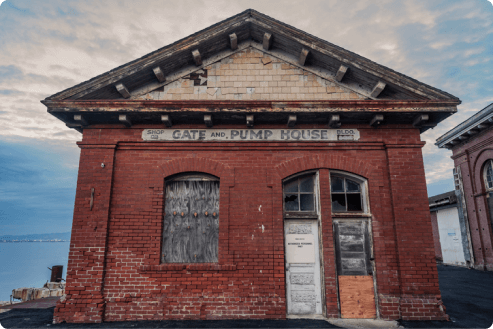Get Your Free Mesothelioma Guide

Find a Top Mesothelioma Doctor

Access Help Paying for Treatment

Shipyards used large amounts of asbestos to build vessels. Shipyard workers and Navy service members faced dangerous asbestos levels while on duty. Their jobs are among the highest risk for mesothelioma and asbestos-related lung cancer.

Asbestos was used in shipyards because it resists corrosion and high temperatures. Those qualities made it ideal for shipbuilding. Asbestos insulation also was used on shipyard equipment. And builders used asbestos sheeting to construct shipyard buildings.
Many ships used asbestos to prevent fires. It insulated boilers, incinerators and steam pipes. Asbestos dust tended to build up in poorly ventilated areas. The buildup led to exposure in shipyards and on ships.
Asbestos products became more common in the mid-20th century. At the same time, experts began recognizing these products could cause diseases. Studies on the dangers of asbestos exposure date back to the 1940s. But it took decades for the U.S. government to admit that inhaled asbestos fibers could remain in the body and cause health issues.
Possible Asbestos Exposure Sites
By the 1970s, the government took the health effects of asbestos more seriously. Workers began removing asbestos from ships and replacing it with safe insulation. Decommissioned ships in today’s shipyards still have old asbestos products. Some materials were temporarily encapsulated to reduce exposure risk. But it poses a hazard to decommissioning workers.
The U.S. Navy used asbestos materials on ships long before World War II. In 1922, the Navy required asbestos to build all new submarines.
The Navy used more asbestos products than any other military branch. Asbestos was once essential on vessels, as it resisted saltwater and prevented fires. Its dangers were unknown at that time.
Types of Asbestos on Ships
In 1939, the U.S. government classified asbestos as a critical material and began stockpiling it. Global demand for asbestos exceeded the supply. That supply found its way to shipyards across the U.S.
In 1932, the U.S. consumed 197 million pounds of asbestos. By 1937, it had soared to 633 million pounds.
The Navy mandate to use asbestos in shipbuilding put millions of people at risk of exposure to asbestos. During World War II, about 4,500,000 men and women worked in shipyards with a high risk of asbestos exposure.
Some jobs required shipyard workers to handle asbestos products directly. These jobs included shipfitters, machinists, maintenance workers, pipefitters, electricians, boilermakers and painters.
Shipyard workers encountered asbestos even if they didn’t directly handle contaminated products. Cutting, sanding and fitting asbestos products around pipes and boilers released microscopic fibers into the air. They could then circulate through the shipyards and contaminate vessels that workers were repairing.
After World War II, the number of shipyard workers fell from 1,700,000 in 1943 to about 200,000. The shipyard worker population stayed at this level until 1976. It fluctuated slightly with the economy and changing shipbuilding practices.
Get Your Free Mesothelioma Guide

Find a Top Mesothelioma Doctor

Access Help Paying for Treatment

As of March 2021, the U.S. had more than 154 active shipyards building vessels. It had more than 300 shipyards for repairs and decommissioning. From 1940 to 1945, the Emergency Shipbuilding Program used 50 shipyards in the war effort.
California leads in shipyard asbestos exposure because it has the third-longest coastline in the U.S. and the Pacific Coast’s first dry dock.
California Shipyard Asbestos Exposure Sites
California’s natural asbestos and many shipyards make it No. 1 in the United States for mesothelioma and asbestosis deaths.
The Navy established the New York Naval Shipyard, also called the Brooklyn Navy Yard, in 1801. It produced countless historic vessels. It was decommissioned in 1966. But workers reported decades of asbestos exposure at the site’s pipe shop, boiler shop, power plant, foundries, shipways and dry docks.
New York Shipyard Asbestos Exposure Sites
New York shipyards were among many asbestos-exposed sites in the state. New York City courts had to create a special division to handle asbestos lawsuits linked to old factories, buildings and shipyards. They call it the New York City Asbestos Litigation division.
In northwestern Washington, Puget Sound was busy with naval shipbuilding during WWII. The Bremerton Naval Shipyard is the largest shipyard on the West Coast. It covers more than 1,300 acres of the sound. Reports on the dangers of asbestos at Bremerton date back to the 1940s.
Washington Shipyard Asbestos Exposure Sites
A 1970 report found lung problems on X-rays of Bremerton workers exposed to asbestos. Insulators and pipefitters were the most affected. Boiler and clerical workers also had lung problems.
Oregon shipyards, like the Albina Engine and Machine Works, were vital to World War II shipbuilding. Albina boosted Portland’s economy and growth in the early 1900s, but it had consequences. Workers at Albina Shipyard, Swan Island Shipyard and Astoria Voyage Repair Station knew these sites as locations of asbestos exposure.
Several major shipbuilding companies operated various U.S. shipyards. Todd Shipyards Corporation, for example, operated yards in Brooklyn, New York; Galveston, Texas; Houston; Seattle; San Francisco; Los Angeles and New Orleans. After Vigor Industrial bought Todd in February 2011, these sites became known as Vigor Shipyards.
Kaiser Shipbuilding Company ran a notable chain of shipyards. Kaiser owned seven along the West Coast. Four were in California, one in Vancouver and two in Portland.
Decades of research have confirmed the harm of asbestos in shipyards.
The varying degrees of risk reported in these studies result from the study groups’ exposure to different amounts and types of asbestos. Even short or long asbestos fiber lengths may affect the degree of risk a worker faces.

Don’t miss out on the benefits you deserve. Find out what VA benefits are available for veterans like you.
Get a RecordingEvidence suggests the Navy’s negligence caused asbestos exposure. But the Feres Doctrine bars veterans from suing the government for compensation. Fortunately, many veterans are eligible for disability compensation and health care benefits provided by the U.S. Department of Veterans Affairs.
Veterans who served in shipyards are eligible for VA benefits if they did not receive a dishonorable discharge and can prove their service exposure is the cause of their disease.
As shipyard workers and Navy personnel developed asbestos-related diseases, they filed claims against asbestos companies. They sought compensation for medical costs and lost wages.
As a result, asbestos product makers sued the U.S. government over liability.
Ultimately, the court held the manufacturers liable. Today, shipyard workers and veterans file mesothelioma claims against asbestos companies and trust funds, not the U.S. government.

As shipyard workers and Navy personnel developed asbestos-related diseases, they filed claims against asbestos companies. They sought compensation for medical costs and lost wages.
As a result, asbestos product makers sued the U.S. government over liability.
Ultimately, the court held the manufacturers liable. Today, shipyard workers and veterans file mesothelioma claims against asbestos companies and trust funds, not the U.S. government.

In July 1983, the Johns Manville Corporation accused the Navy of allowing “gross exposure to asbestos fibers” in its shipyards. It cited a classified 1944 health survey at Navy contractor Bath Ironworks, which found asbestos at 10 times the safe level. A company lawyer claimed the Navy bought asbestos from Africa. It then sold it to Johns Manville for a profit.
At the time of these allegations, the company was preparing to sue the U.S. government for $1 million. This was to recover damages paid to settle asbestos lawsuits. Johns Manville faced 20,000 lawsuits seeking nearly $40 billion in damages.
In addition to applying for VA benefits, many Navy veterans and former shipyard workers have turned to mesothelioma lawsuits to recover the costs associated with diagnosing an asbestos-related disease. The government cannot be responsible for asbestos exposure. But negligent manufacturers of asbestos-containing products often can be.
A 2003 Wall Street Journal article said veterans’ claims made up 26% of mesothelioma cases, 16% of lung cancer cases and 13% of disabling lung disease cases. These claims were for exposure in military and shipyard construction.
Shipyard workers who suspect asbestos exposure should tell their doctors and request tests for asbestos-related illnesses. Documenting your asbestos exposure history in case you develop a condition is also wise.
If you have legal questions about compensation, consult a mesothelioma attorney. They can advise you on your options based on your diagnosis and exposure history.
Asbestos is not banned in U.S. shipyards. In 1989, the U.S. Environmental Protection Agency tried to ban all asbestos products. It became a partial ban that included only six products.
Asbestos was used to build ships because it is naturally resistant to saltwater corrosion and effective at preventing fires on vessels. Asbestos insulation was used on shipyard equipment. Asbestos sheets were a cheap way to build shipyard buildings.
Shipyards may be importing asbestos gaskets or brakes. But this information is not public. No U.S. agency is required to track asbestos imports. It is not likely that shipyards have imported asbestos products in recent years.
Your web browser is no longer supported by Microsoft. Update your browser for more security, speed and compatibility.
If you are looking for mesothelioma support, please contact our Patient Advocates at (855) 404-4592
The Mesothelioma Center at Asbestos.com has provided patients and their loved ones the most updated and reliable information on mesothelioma and asbestos exposure since 2006.
Our team of Patient Advocates includes a medical doctor, a registered nurse, health services administrators, veterans, VA-accredited Claims Agents, an oncology patient navigator and hospice care expert. Their combined expertise means we help any mesothelioma patient or loved one through every step of their cancer journey.
More than 30 contributors, including mesothelioma doctors, survivors, health care professionals and other experts, have peer-reviewed our website and written unique research-driven articles to ensure you get the highest-quality medical and health information.
My family has only the highest compliment for the assistance and support that we received from The Mesothelioma Center. This is a staff of compassionate and knowledgeable individuals who respect what your family is experiencing and who go the extra mile to make an unfortunate diagnosis less stressful. Information and assistance were provided by The Mesothelioma Center at no cost to our family.LashawnMesothelioma patient’s daughter


Munz, A. (2024, November 27). Asbestos Exposure in Shipyards. Asbestos.com. Retrieved July 28, 2025, from https://www.asbestos.com/shipyards/
Munz, Aaron. "Asbestos Exposure in Shipyards." Asbestos.com, 27 Nov 2024, https://www.asbestos.com/shipyards/.
Munz, Aaron. "Asbestos Exposure in Shipyards." Asbestos.com. Last modified November 27, 2024. https://www.asbestos.com/shipyards/.
Danielle DiPietro is a Financial Advocate and VA-accredited claims agent at The Mesothelioma Center, the nation’s most trusted mesothelioma resource. She helps all mesothelioma patients and their families, including veterans, find the best answers to their financial and VA questions.
Our fact-checking process begins with a thorough review of all sources to ensure they are high quality. Then we cross-check the facts with original medical or scientific reports published by those sources, or we validate the facts with reputable news organizations, medical and scientific experts and other health experts. Each page includes all sources for full transparency.
Please read our editorial guidelines to learn more about our content creation and review process.
